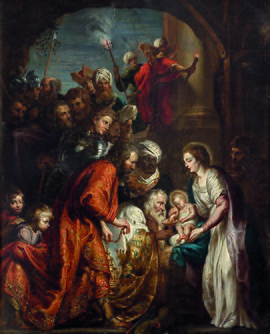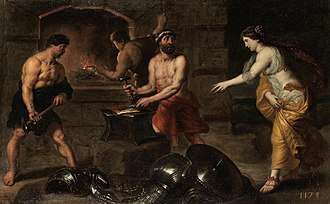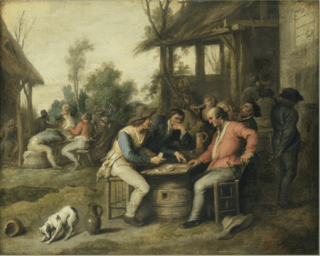Vincent Malo
Vincent Malo or Vincent Malo I (Cambrai 1585/1605, (ca. 1595) – Rome, 1649) was a Flemish painter who after training and working in Antwerp was mainly active in Italy, where he was known, amongst others, as Vincenzo Malo and Vincenzio Malo.

Life
Malo was a pupil of the leading Flemish Baroque painters David Teniers the Elder and Peter Paul Rubens and they taught him the Flemish Baroque style. Between 1623 and 1634 he worked in Antwerp. During this period he was a member of the Antwerp Guild of St. Luke. He married in Antwerp and had a son also named Vincent in 1629. His son would later also become a painter and be known as Vincent Malo II.[1]
He moved to Genoa after 1634 where he lived and collaborated with fellow Flemish painter Cornelis de Wael, who played a pivotal role in the Flemish community in Genoa.[2] Genoa was at the time an attractive destination for artists since the competition between artists there was less intense than in the leading cultural centres Rome, Florence and Venice. Genoa was a thriving port city where a large number of potential patrons and collectors lived.[3] In Genoa Malo completed various commissions for local churches and palaces.[1]
Malo later travelled to Florence with his family and resided and worked there for a while. He then travelled to Rome where he died not long after his arrival at the age of 45.[4] His family returned to Antwerp and in 1652 his son was admitted in the local Guild of St. Luke as the son of a master.[1]

Isaac Wigans was his pupil in Antwerp and Antonio Maria Vassallo in Genua.[5]
Mix-up of Vincent Malo with other artists
The details of Vincent Malo’s life are relatively obscure and confuse. In 1662 the Flemish biographer Cornelis de Bie called him the "Great Master Vincent Malò" who painted large and small works with a great feeling for flesh tones. De Bie did not specify any dates for Malo. The earliest biographer naming a Vincenzio Malo is Raffaello Soprani in his 1768 publication about artists in Genoa Le vite de' pittori, scultori, ed architetti genovesi. This book is still our primary source of information on Malo.[4]
Timon Henricus Fokker suggested in a publication of 1931 that Vincenzo Malo should be identified with the Vincenzo Armanno described in Passeri’s book Vite de pittori, scultori ed architetti: che anno lavorato in Roma, morti dal 1641 fino al 1673.[6][7] The art historian Didier Bodart has argued in a 1970 article against this identification. He has expressed the view that the Vincenzo Armanno described by Passeri should rather be identified with the Dutch painter Herman van Swanevelt. Bodart compared the biography of Vincenzo Armanno by Passeri with that of Vincent Malo by Soprani. He arrived at the conclusion that the lack of similarity between the lives of the two persons described in these biographies proves that Armanno and Malo were two different persons. Moreover, some facts recorded about van Swanevelt’s life such as his troubles with the Holy Office in Rome and his specialisation as a landscape painter make him the more likely candidate for identification with Vincenzo Armanno.[8] The matter of the identity of Vincenzo Armanno has still not been resolved with certainty.

Vincent Malo has sometimes also been confused with the Flemish painter Vincent Adriaenssen who spent time in Rome. In fact, both painters of that name (Vincent Malo I and Vincent Malo II) had died before Vincent Adriaenssen. Today it is assumed that Malo made religious and genre works and Adriaenssen painted battle scenes.[9]
Works
Vincent Malo was a painter of genre scenes and of religious and mythological subjects. Works of Vincenzo Malo are held in the collections of the Accademia Ligustica di Belle Arti (Genoa), Palazzo Bianco (Genoa), Palazzo Colonna (Rome), Galleria nazionale di Parma (Parma), Vatican Museums (Rome), Pinacoteca di Brera (Milan), the Rijksmuseum (Amsterdam), the Indiana University of Pennsylvania Art Gallery (Indianapolis). The Royal Collection holds three religious paintings attributed to Malo but these attributions are not firm.[10]
References
- Vincent Malo at the Biographie Nationale de Belgique, Volume 13, p. 251-253 (in French)
- Vincent Malo in Het Gulden Cabinet, by Cornelis de Bie, page 143, Antwerp, 1662 (in Dutch)
- Anversa & Genova: een hoogtepunt in de barokschilderkunst (in Dutch)
- Raffaello Soprani con note di Carlo Giuseppe Ratti, Le vite de' pittori, scultori, ed architetti genovesi, Tomo I, Stamperia Casamara, Genova, 1768, pag. 332 e pag. 468-469 (in Italian)
- Vincent Malo (I) at the Netherlands Institute for Art History (in Dutch)
- T. H. Fokker, Werke Niederländischer Meister in den Kirchen Italiens’’, Studiën van het Nederlandsch Historisch Instituut te Rome, 1931 (in German)
- Giovanni Battista Passeri, Vite de pittori, scultori ed architetti: che anno lavorato in Roma, morti dal 1641 fino al 1673, Presso Gregorio Settari, 1772 (in Italian)
- Didier Bodart, ‘’Les peintres des Pays-Bas méridionaux et de la principauté de Liège à Rome au XVIIeme siècle, Volume 1’’, Institut historique belge de Rome, 1970, p. 331-333 (in French)
- Vincent Adriaenssen at the Netherlands Institute for Art History (in Dutch)
- Vincent Malo paintings at the Royal Collection
Further reading
- s.n. 1997: 'Fiamminghi a Genova 1602-1656', in: BARNES, S. e.a. 1997: Van Dyck a Genova. Grande pittura e collezionismo, tentoonstellingscatalogus Genua, Palazzo Ducale, Milaan, pp. 352–357.
- BALIS, A. 1993: ‘“Fatto da un mio discepolo”: Rubens’s Studio Practice Reviewed’, in: Rubens and his workshop: the flight of Lot and his family from Sodom, tentoonstellingscatalogus, Tokio, p. 101.
- MARZIA, C.G., MASSA, P. (e.a.) 2003: Anversa & Genova. Een hoogtepunt in de barokschilderkunst, catalogue Antwerpen, Gent.
- THIEME, U.; BECKER, F. 1929: Allgemeines Lexikon der bildenden Künstler: von der Antike bis zur Gegenwart. Deel 23, Leipzig, p. 598.
- DUVERGER, E. 1985: Antwerpse kunstinventarissen uit de zeventiende eeuw. Deel 3 en 4, Brussel, p. 61 (dl. 3), p. 159 (dl. 4).
- RUTTERI, Maria Grazia, Vincenzo Malo dal manierismo al barocco, 1966.
External links
